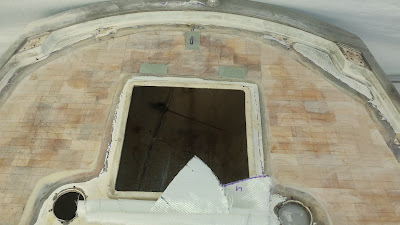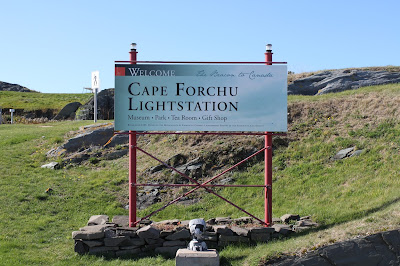I hope all our family, friends and followers has a peaceful and relaxing Thanksgiving weekend. We had a wonderful holiday. It was restful and happily spent with friends who have become like family to us.
As usual, they cooked up a feast, and this year I was the honorary turkey chef. We deep fried the turkey and it was absolutely delish! Of course we also had the traditional Thanksgiving staples like baked ham, mashed potatoes, stuffing, green beans, corn, cranberry sauce and gravy.
Enjoying a turkey leg, a cold beer and some football!
After dinner we indulged in some great homemade apple crisp and ice cream. Then everyone in the house took a well-deserved nap, crashing out on the couches and floor in the family room.
Prior to heading over to our Thanksgiving dinner I managed to get a bit of boat work done. The weather was great, 70 degrees and sunny, couldn't ask for a nicer day.
I began sanding down the fairing epoxy (pinkish area). The fairing epoxy helps fill in the low spots, making a nice smooth surface.
This is looking at the starboard side after initial layer of fairing epoxy was sanded. You can see the varying shades and colors, which is the different layers of fiberglass and fairing expoy making a smooth surface.
Starboard side
Port side of lazarette is looking more level and fair (flat surface). From here on out the sanding on the lazarette will be completed by hand with a long board...not looking forward to that one bit. They call it torture boarding! On the next warm day I will add more 407 West Systems fairing epoxy to the deck and begin the torture boarding!
Yesterday I captained a short family-friendly "Santa" cruise on the whale-watching tour boat that I've been driving for occasionally. Afterwards, with yet more beautiful weather on tap, I decided to explore additional areas of Sal for rotten core. I knew there would be more to find, especially on the side decks. This was because they would always creak a bit when walked upon, and while sailing I would see some of the deck flexing when stanchions were bumped...a good indication the core was rotten in those areas.
First place I decided to cut was the jib track area on the port side deck. I knew if anywhere was going be wet and rotten it would be here. When removing the fasteners that had secured them to the deck in preparation for refit, I found that they were all hand-tightened and had almost no sealant on them. I have a strong suspicion these bolts had never been tightened or resealed throughout Sals 44 years of existence. Honestly, I'm just as guilty as everyone else who owned Sal; I never checked them.
Here is a rotten area also on the port side deck. This is where a stanchion was and you can kind of see the outline of a stanchion base. Obviously our Alberg has had rotten decks for some time. Looks like someone long ago tried to repair the area by pouring some resin filler and sanding it smooth.
This is not really a big thing as I will eventually replace it all and make it better than new.
As I was cleaning out the area and seeing how wet the core was, I noticed the core didn't look quite right. Yes it was wet, soft and rotten, but something else also seemed off. As I looked closer I began to realize the that core was thinner than the lazarette area. I grabbed a square of the new 3/8 core and laid it in the cut-out area. Sure enough, the old balsa is thinner than the 3/8, and my side decks are apparently different than every other Alberg 30 I have ever read about.
After some measuring I determined that Whitby built my Alberg 30's side decks with 1/4 inch balsa and not the 3/8 inch I have read about on other Albergs. The top skin also appears to be thinner as well, only about .130 (thousandths of an inch) or about 1/8 inch thick. The lazarette area used 3/8 core and top skin was about .180 or 3/16 of an inch. Another difference is the bottom deck skin: It was a lot thicker, almost .200 where the lazarette was maybe .060 or so. I guess Whitby had some 1/4 balsa core they needed to get rid of... who knows!?
This photo shows how much thicker the new core is than the old stuff I took out.
So maybe I have an odd side deck, nothing too major. I believe I can exchange out the new 3/8 balsa core for 1/4, thankfully I bought it locally. I don't believe my decks are any weaker or stronger than any other Alberg 30. I think Whitby made up for the lack of core thickness with lower deck skin. This week I will work on obtaining some 1/4 balsa core and begin the side decks.
Boat Repair: It's always something!
Stay tuned










































